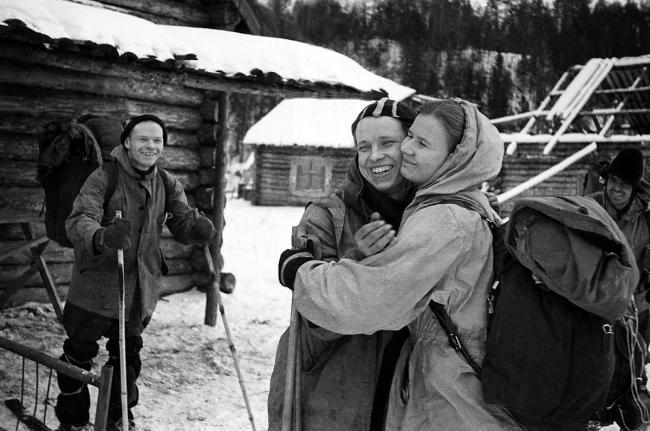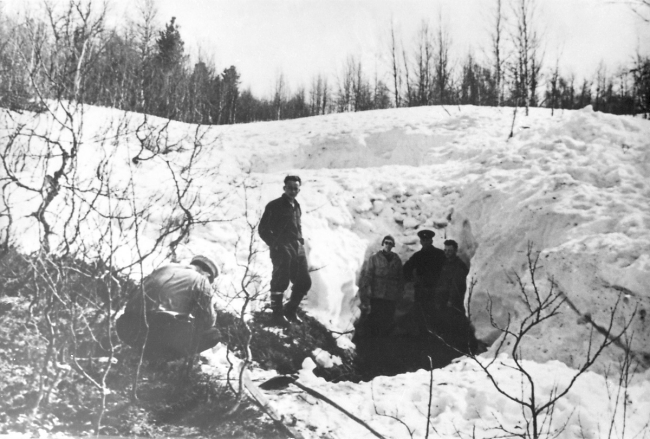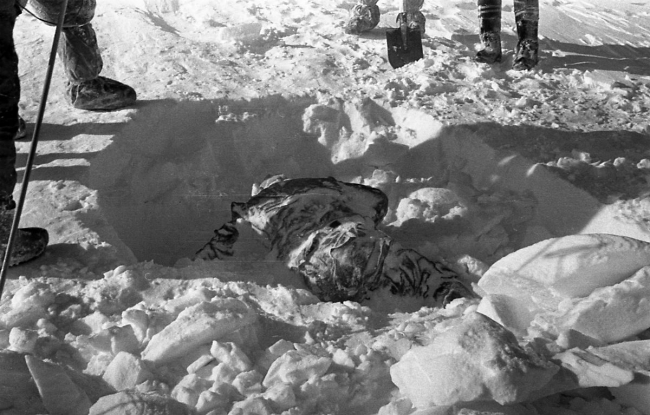The criminal case on the death of the Dyatlov group was cut short
This is the opinion of lawyers who carefully studied the documents of the investigation during the prosecutor's check.
All rights belong to Komsomolskaya Pravda. Authors Nikolay Varsegov and Natalya Varsegova
Text in Russain

The criminal case on the death of hikers is a puzzle that not a single researcher could solve.
In the winter of 1959, nine hikers disappeared in the mountains of the Northern Urals. They were participating in a trek led by Igor Dyatlov, a fifth-year student of the Ural Polytechnic Institute. For 18 days, the group had to ski 300 kilometers in the north of the Sverdlovsk region, ascending two peaks. The hike was of the highest category of difficulty according to the 1950s classification. A month after the group went missing, rescuers found their tent cut open and five frozen bodies within a radius of one and a half kilometers on the slope of an unnamed pass. The corpses of the rest were found only in May. The investigation found that some of the hikers died from the cold, but some of them had fatal injuries of unknown origin. What exactly happened to the Dyatlov group is still unknown.
The criminal case on the death of the hikers is a puzzle that not a single researcher could solve. It seems to be specially poorly stitched together so that no one would guess about the true cause of death of nine young and healthy people. Or it was led by very careless investigators who wanted to spit on many procedural nuances. In the case, for example, there are no orders to conduct a forensic medical examination of the corpses. The histology results of five dead hikers are nowhere to be found. It is not clear who is investigating the tragedy: the prosecutor of Ivdel Vasiliy Tempalov or the prosecutor-criminalist from the regional prosecutor's office Lev Ivanov? For some reason, there is no good operational photography. All photos are like from an amateur photo album. And where did the interrogation of February 6 come from, if the investigation itself began on February 26? And there is more.

28 January, 1959, 2nd Northern
To understand the peculiarities of the investigative actions of 1959, it was necessary to compare the case of the Dyatlov group with other criminal cases of that period. This was done last year during an official check, which was carried out by the prosecutor's office of the Sverdlovsk region at the request of Komsomolskaya Pravda.
Three experts from the Ural State Law University tried to answer the following questions:
– Was the criminal investigation into the death of the hikers been carried out in accordance with the requirements of the criminal procedure legislation and the rules of investigative actions at the beginning of 1959?
– Were there any violations during the investigation, rendering the evidence collected in the case inadmissible?
– Is the level of investigation in this case comparable to that of other cases in the same period?
Facts only
The case on the death of Igor Dyatlov's group was initiated on February 26, 1959 and terminated on May 28, 1959. The investigation period is 3 months.
Carried out were: 5 inspections of the scene of the incident, compiled a map of the area and sketches of the campsite of the group. Including: photographing the scene of the incident and where the bodies were found, 9 forensic medical examinations, forensic and physical-technical expertise. 49 witnesses and an expert were questioned.

The place of death of the Dyatlov group
Violations
– Some protocols of investigative actions were not signed by the attesting witnesses who were present during these procedures. For example, the act of the forensic medical examination of Slobodin's body was not signed by the witness S.V. Gordo, the acts on Kolevatov, Zolotaryov, Thibeaux-Brignolle and Dubinina were not signed by the forensic expert Churkina.
– Numerous reservations, amendments, erasures of interrogation protocols and other investigative actions in the protocols are not confirmed by the signatures of the respondents.
– The material evidence was not described in detail and was not attached to the case by a special decree. In addition, the fate of material evidence is not determined in the decision to terminate the case.
– The investigation period was extended to three months on April 30, 1959, while the two-month investigation period expired on April 28, 1959.
– The protocols of the examination of the corpses found under the cedar do not indicate the time of the examination and the temperature of the ambient air.
– The description of the situation at the scene of the incident is inconsistent, which "does not contribute to the formation of a correct idea of the location of the inspection and what happened there".
– The protocol of the inspection of the place under the cedar does not describe all the objects and items found there.
– Interrogation records are not detailed enough.
– The acts of forensic medical examination are short and not informative.
– There was no planning of the preliminary investigation, different versions of the development of the event were not checked.

The case of the death of the Dyatlov group was initiated on February 26, 1959 and terminated on May 28, 1959.
Investigative error in other cases
For comparison, the experts studied other criminal cases of 1958-1960 in order to understand whether the flaws in the Dyatlov group case were typical for that period or not. Here are the findings:
– In the criminal case of July 21, 1960 on the MI-4 helicopter crash in the region of Ivdel, there are no signatures of the investigator and attesting witnesses under the act of forensic medical examination. Material evidence is not attached to the case by a special decree.
– In the criminal case of September 2, 1960, on the fatal injury of three people at the Yasashnaya station, the acts of the forensic medical examination are not very informative and are written by hand on notebook sheets. The decision to dismiss the case was not signed by the investigator and not approved by the prosecutor.
– In a rather weighty criminal case of October 29, 1959, into the disappearance of citizen Krutikov (two volumes in 236 and 117 pages), three witnesses were questioned after the case was closed. The decision itself to terminate a year later was canceled by the resumption of the case, but without the sanction of the prosecutor.
– In the criminal case of October 6, 1959, on the murder of citizen Glinskih, there is no order to extend the investigation, and the act of the forensic medical examination was not signed by the attesting witnesses.
– In the criminal case of September 29, 1958, on the abuse by the accountants of the Klyuchevskoy Sawmill, all investigative actions were carried out outside the time frame for the investigation, except for the interrogation of two witnesses. One of the protocols did not even have a date.
– On February 6, 1958, an investigation into the fire in the village of Koshay began. It was established that it was arson. But they did not try to find who's responsible. They just closed the case without any explanation.
– In the criminal case of September 10, 1958, on the death of Lyubyakin in the village of Bulanash, the decision to terminate the proceedings was made outside the investigation period. The seized weapon has not been examined, it has not been attached as material evidence, its further fate has not been decided. A forensic examination of the corpse was carried out on April 30, 1959, although the investigation was completed on December 31, 1958. From the authors: how long did the corpse lie in the morgue - 8 months? Or the examination was carried out in September, and only the protocol was signed at the end of April?
Conclusion
Quote the experts: "It should be noted that all versions of the circumstances of the death of the hiker's group were not thoroughly examined. Thus, the investigating authorities fully worked out the version of the murder by the Mansi people, but other versions, in particular of an avalanche, a hurricane in the area of ??the violated camp, and others, were actually not fully verified. According to the results of a preliminary investigation, it was established that the death of the hikers was caused by hypothermia, and not as a result of someone's criminal actions. However, all the reasons and circumstances of the incident were not established. The decision to terminate the criminal case was made prematurely."
From the authors
Investigative negligence, mistakes of investigators quite often happen in our time. There are plenty of examples of this. However, it is surprising that if one or two violations were revealed in other cases of the 50s, then there are too many of them in the case of the death of the hikers. And this despite the fact that the case was under the control of the RSFSR prosecutor's office and even the Central Committee of the CPSU. Did they treat this case from above with the same negligence, or did they the intention to create a puzzle to confuse everyone?
Lawyers' opinions
Lawyer Anton Sokolov:
"It is strange that in this so-called examination there is no data on specialists confirming their competence in the issue under study - diplomas of relevant education, information about their work experience, and, most importantly, about their specialization are not attached - the question of whether they are specialists in areas of criminal procedure and criminal law. In addition, this document cannot be called an examination, which, as a rule, is assigned only within the framework of a criminal case. In our case, this is a study and, according to the law, experts are not responsible for the reliability of the conclusions within the framework of criminal law. Just the opinion of three experts about one investigated case. Moreover, on some issues their opinion is rather controversial.
For example, the two-month period of preliminary investigation into the death of Dyatlov's tourist group expired on April 28, 1959. The investigation was extended for up to three months on April 30, 1959, that is, in fact, "retroactively", which is a gross violation, entailing the recognition of evidence collected outside the time frame of the investigation - inadmissible. But experts do not attach any importance to this."
Lawyer Olga Desyatova:
"What is inadmissible evidence? This is evidence that cannot be cited in a criminal case. But this fact is practically ignored by experts. However, on the other hand, they indicate that the case is not fully investigated. Not considered all versions, etc. Today we can say that in fact, all those violations, which are written about in the examination, can serve as a basis for canceling the decision to terminate the case."